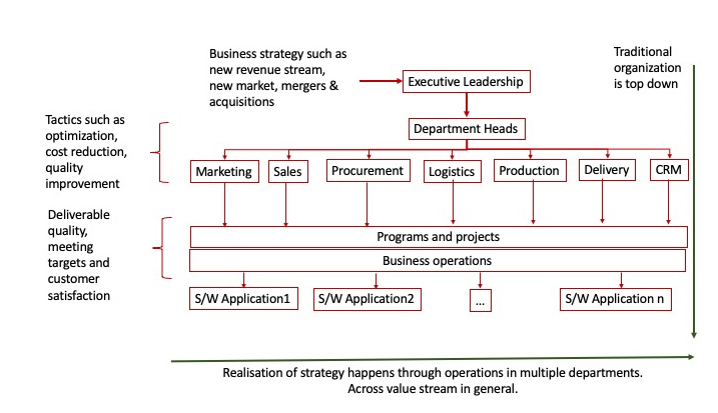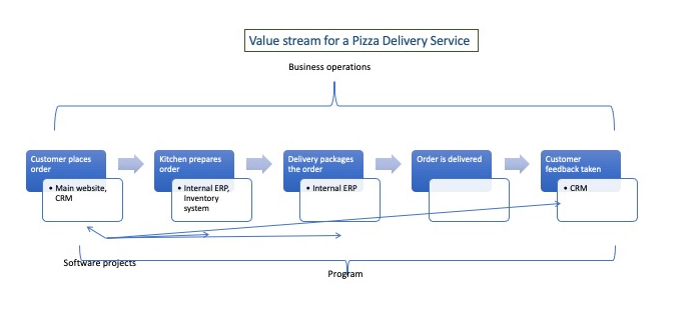By Nagaraja Gundappa
May 1, 2024
First things first – let’s define business agility:
Business agility, alternatively called enterprise agility and organizational agility, is the ability of an organization to rapidly adapt to market and environmental changes in productive and cost-effective ways according to PMI’s Disciplined Agile. So, business agility is not just many projects across the business adopting agile software development. It is not even a question of all departments adopting agile methods.
Building on this definition, how do organisations rapidly adapt to market and environmental changes? By quickly coming up with strategies that gear up the business to thrive amidst the changes and implement the strategy in its operations. So, the ability to quickly come up with strategies and implement the strategy in the form of operations is business agility. Further, nearly all business operations today are carried out using software and the ability to make changes to all applications and products that implement the new strategy determines business agility.
The next step is to understand what impedes business agility and what enhances business agility. Let us focus on one factor that impedes and can enhance business agility as well if handled well – organization structure.

Diagram 1: Strategy to operations in traditional organization structure
Diagram 1 above illustrates in a very simplified manner how traditional organisations work. Organisations are typically divided into production or line functions and then the support functions. The top management comes out with annual plans and allocates budget to different departments who would each have their own priorities and utilize the budget to run their programs, projects and operations. The interaction between the departments, the accountabilities, and deliverables for each other among the department also goes on largely according to annual plans.
In such a setup, if an organization comes up with a new strategy midway through the year, let us see how the strategy is implemented. Most strategies result in some change that is customer-facing. So, the strategy has several parts to be implemented by different departments and the CxO level delegates the strategy implementation to dept heads. The dept heads will add this piece along with their other operations and departmental projects. The departments may have some co-ordination, but several questions arise:
- How will the depts get an additional budget for this new work resulting out of new strategy? Who distributes the strategy budget to depts and how? This process is cumbersome, and much time is lost in this process.
- Each dept may have its own priorities. Who will co-ordinate with each dept to prioritise the work arising out of the new strategy?
- Going further into prioritization, who will ensure that the features or modules on which others have maximum dependency are scheduled early for release?
- If resources have to be shared between departments for this strategy implementation, what will be the basis and who can take a final call on resource sharing?
If there is no clarity in answers to the above questions, it constitutes impedance to workflow and is considered lack of business agility. The departments work in their own fashion and sometimes even at cross purposes with other departments and cannot quickly adapt to new strategies or changes to the strategy. Organisations will be slow to react to market and environmental changes. Because of this tardiness in implementing strategies, organisations hesitate to come up with effective or aggressive strategies. So, what is the solution to the impedance and improve business agility? A different way of organizing – organizing around value.
Let us get back to the first principles – what is value and value stream? A series of processes that are carried out to produce value, that is some product or service which the customer buys and is willing to pay money. These processes cut across multiple departments as shown in diagram 2 below.
The sequence of processes carried out starting from a customer order to customer delivery is the value stream. In the example, Pizza is the value that a Pizza restaurant produces, and all the process carried out to take a customer order till delivery to customer is a value stream.

Diagram 2: Value stream for a Pizza delivery service
Why are we bringing in value stream here? Because Strategies map to value streams at operations level. It is the value stream that implements a strategy. Continuing with the Pizza example, let us say hypothetically that sales at a Pizza restaurant is down because of competition and their strategy is to introduce a new product line, say Dosa, a popular Indian Dish. How do they implement this strategy? By making changes to the above value stream. The procurement will have to procure raw materials required for Dosa into the inventory, the web site and other UIs will have to include Dosa in the menu, their accounting will have to now include the spending and earning on Dosa, packing and delivery has to adapt to this new dish which could be handled in a different way. So, all operations in the value stream would change which means all different software applications that aid these business operations will need enhancement. Having defined the value stream, let us now look at how to organise around value stream:
- After the CxO level comes up with a new strategy, they identify the affected value stream.
- A manager is assigned to the value stream who would have matrix relationship, reporting to the CxO level on one hand and some relation with the dept heads on the other hand and this person co-ordinates and takes decisions related to the entire value stream.
- Budget is allocated to the value stream and is distributed to the depts based on the size of change at each dept.
- Program management is not department based, but value stream based. This means that all the applications that enable the operations in the value stream are grouped together into a program. The value stream manager could be the program manager or work closely with the program manager. This is the most important step in organizing the value stream.
- The program manager can rotate resources from one team to another depending on the need and priority relative to the value stream. This would not be easy if departments were functioning independently.
- Program managers can decide priorities of features or modules of various applications owned by different departments based on their importance to the value being produced. The higher the contribution of a feature to the value, the higher the priority of that feature. The departments could not do this without a complete picture of the value stream.
- Program managers can co-ordinate and determine dependencies easily and can ensure that the features on which there is more dependency is scheduled earlier.
So, there you go: the value stream provides a basis for everything needed to organize and implement a strategy. Budget allocation, resource allocation and movement, prioritization, dependency management and change management.
This means that strategies can be implemented very fast and in a flexible manner that can easily respond to midcourse changes. Armed with this ability, organisations can come up with effective strategies and tweak these strategies midcourse. This is what business agility is all about and organizing around value increases business agility.
Connect with IIL Consulting on Enterprise and Business Agility here!
Nagaraja Gundappa, whom you can call Naga is a Digital Transformation expert and software delivery transformation is his special area of interest. He covers most areas in the Digital Transformation Canvas that includes process transformation, Agile Delivery, Design Thinking, AI, Data Science, Platform Technologies, and Enterprise Architecture. He is a trainer and consultant and has been associated with IIL for more than 10 years.
He is an M.Tech. Degree holder in computer science and started his career in Artificial Intelligence as applied to fault tolerant flight control systems. He then has served in IT service sector and delivered large complex projects and programs for global customers that include General Motors, Deloitte, Honeywell and so on. As a General Manager, Wipro Technologies, he has led a delivery excellence program where 1200 project managers were trained, assessed, and mentored and the program resulted in cost reduction by 13%. He conducts training in the areas of complex project management, SAFe 6.0, Kanban, Scrum, many PMI courses, Design Thinking and Business Analysis. He is a speaker at many industry forums and has many publications and presentations to his credit.
You can connect with him at: https://www.linkedin.com/in/nagarajagundappa/
Disclaimer: The ideas, views, and opinions expressed in this article are those of the author(s) and do not necessarily reflect the views of International Institute for Learning or any entities they represent.






